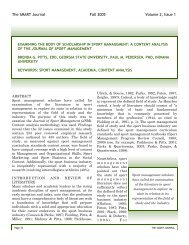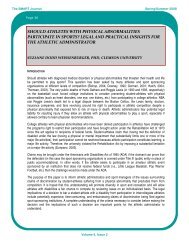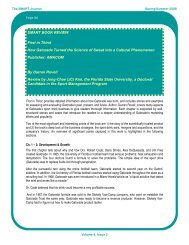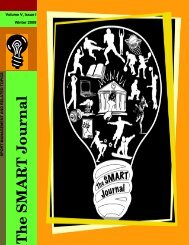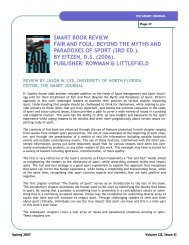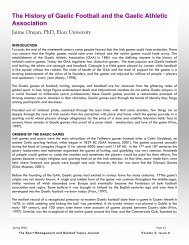Spring/Summer 2008 Volume 4, Issue 2 - The SMART Journal
Spring/Summer 2008 Volume 4, Issue 2 - The SMART Journal
Spring/Summer 2008 Volume 4, Issue 2 - The SMART Journal
You also want an ePaper? Increase the reach of your titles
YUMPU automatically turns print PDFs into web optimized ePapers that Google loves.
<strong>The</strong> <strong>SMART</strong> <strong>Journal</strong> <strong>Spring</strong>/<strong>Summer</strong> <strong>2008</strong><br />
Page 20<br />
35 (25%) average over $200,001. Thirteen (10%) of the respondents were non-Caucasian and 125 (90%) were<br />
Caucasian. <strong>The</strong> respondents were asked how many professional football games they have averaged attending<br />
the past years. <strong>The</strong> results revealed that 70 (51%) attended 1-3 home football contests, 31 (22.5%) were<br />
attended 4-6 games while 37 (26.5%) attended 6 or more games in the previous years. Only 46 (33%) of the<br />
participants have entered a Super Bowl since 9/11.<br />
PERCPETIONS OF TERRORIST ATTACK<br />
Ninety-six percent of the respondents perceived a strong likelihood that a terrorist attack would be attempted or<br />
occur at a Super Bowl within the next three to five years. However, 72% agreed that they would not change<br />
travel plans even if the Department of Homeland Security raised the terrorist threat level to red. Despite the<br />
previous responses, 64% indicated that they felt safe attending the Super Bowl.<br />
PERCIEVED LEVELS OF SECURITY<br />
Seventy-four percent of the respondents indicated that security has not become more relaxed at sporting<br />
events since 9/11 and that 86% were satisfied with the level of security. To increase security, only 35% were<br />
willing to pay an increase in ticket price for better security. When asked to identify an organization that should<br />
be responsible for the security aspects of the Super Bowl, 64% believed that the host city should be followed<br />
by the federal government (43%) and the National Football League (36%). Thirty-five percent indicated that<br />
mega-events such as the Super Bowl should have security provided by national federal agencies such as the<br />
Transportation Security Administration (TSA) which is extensively used at most airports, while 30% did not.<br />
PERCEPTIONS OF SECURITY EQUIPMENT MEASURES<br />
All of the participants that completed this section indicated that stadiums in the NFL and all other agencies<br />
should use any security equipment necessary to provide a safe and secure atmosphere. When asked about<br />
the implementation of certain security measures at the Super Bowl, 79% of the respondents were aware of the<br />
increase in security. Specifically, 84% of the participants noticed the use of closed-circuit televisions (CCTV) for<br />
security use outside the stadium. While a much smaller percentage of the respondents (32%) noticed the use<br />
of CCTV’s inside the stadium, 63% reported that using such an item could assist in creating a safer and more<br />
secure environment. In contrast, less than half of the respondents felt that closed-circuit televisions should be<br />
used in downtown venues of the host city. It was evident that spectators were aware of the increased level of<br />
security measures in the parking areas, as 66% noticed that cars were being checked thoroughly. Nearly the<br />
same number (62%) reported that security personnel were visible in and around the parking lot area.<br />
Sixty-seven percent of the respondents indicated that stadiums have the right to check items being brought into<br />
the stadium to protect the public from acts of violence. As such, 71% did not agree that carry-in checks were a<br />
nuisance that may explain why 64% agreed that all spectators carry-ins should be checked before entering the<br />
stadium. When participants were asked about the use of metal detectors at the Super Bowl, 74% indicated that<br />
such security equipment should be used. Fifty-one percent indicated that the Super Bowl venue should use<br />
face recognition equipment to protect the spectators. Eighty-one percent of the respondents did not believe that<br />
their personal privacy was violated by any of the security issues noted previously.<br />
DISCUSSION<br />
Sporting events have become vulnerable to terrorist attack for three main reasons (Schneider, 2002). First, the<br />
venues are symbolic targets. American sports symbolize American culture (Sage, 1998). Second, these venues<br />
are difficult to secure because large groups of people gather entering and leaving the facilities. Third, sporting<br />
venues have been attacked in other countries demonstrating their attractiveness as a target. Thus, sporting<br />
<strong>Volume</strong> 4, <strong>Issue</strong> 2



